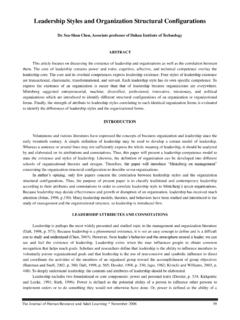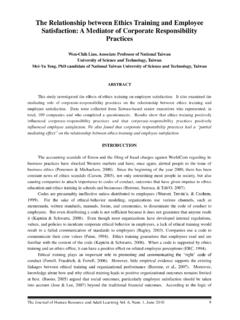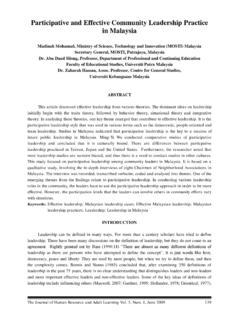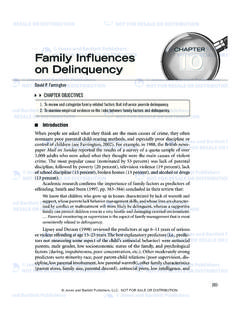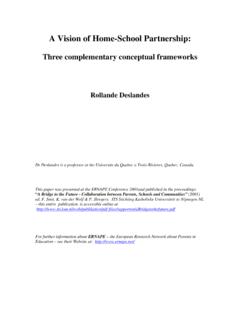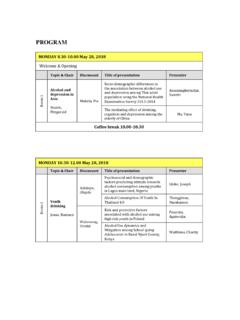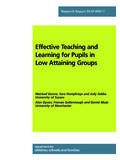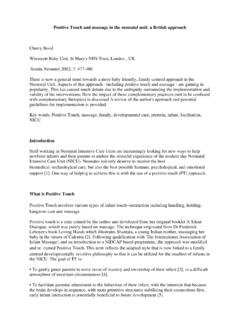Transcription of Job, Family and Individual Factors as Predictors of …
1 The Journal of Human Resource and Adult Learning Vol. 4, Num. 1, June 2008 57 Job, Family and Individual Factors as Predictors of Work- Family Conflict Aminah Ahmad, Universiti Putra Malaysia ABSTRACT The growing interest in understanding fully the interface of work and Family roles and their antecedents has stimulated the development of a predictive model of work- Family conflict. A model is developed on Predictors of work- Family conflict which suggests that the Predictors could be job-related (job type, work time commitment, job involvement, role overload, job flexibility), Family -related (number of children, life-cycle stage, Family involvement, child care arrangements) and Individual -related (life role values, gender role orientation, locus of control, perfectionism).
2 This present model is based on the stress-strain model (Dunham, 1984) whereby the Predictors are referred to as stressors, and the conflict as strain. INTRODUCTION Changes in the workplace and demography of employees have made studying the relationship between work and Family more important. Research that examines work- Family conflict has advanced over the last few decades and has led to the development of theoretical models, empirical studies, and organization-sponsored work- Family initiatives. As organizations attempt to help employees manage the balance between work and Family demands, there is a growing body of research on the topic of work- Family conflict.
3 Besides the rapid increase of married women entering the work force while continuing to maintain the majority of the Family and household responsibilities (Jackson, Tal, & Sullivan, 2003), the interest in the topic has also in large measures been fuelled by the recognition that work- Family concerns are highly salient for the well-being of employees. Empirical evidence also confirms that work- Family conflict is often a severe stress factor at work leading to various negative outcomes, including impaired well-being (Karatepe & Tekinkus, 2006).
4 Researchers have identified work- Family conflict as one of the major stressors in the workplace in the United States (Allen, Herts, Bruck, & Sutton, 2000; Frone, 2003). In Canada, time in employment increased for many, as did the non-work demands resulting from the continued change in Family structures and the continued rise in the percentage of employees with child care, elder care or both (Duxbury & Higgins, 2003). Men have assumed more Family responsibilities, in part due to high rates of divorce resulting in increased involvement in single parenting (Gill & Davidson, 2001).
5 As a result, many men, like women, are beginning to experience increased levels of stress and conflict as they juggle work and parenting responsibilities (Tennant & Sperry, 2003). The concept of work- Family conflict has been explained by Kahn, Wolfe, Quinn, Snoek, & Rosenthall (1964) using the role theory framework. They proposed that the major determinant of an Individual s behavior is the expectation of behavior that others have for him or her. The role theory predicts that the expectation surrounding each of these different roles a person performs can generate inter-role conflict when they involve pressure to dominate the time of the focal person to satisfy all The Journal of Human Resource and Adult Learning Vol.
6 4, Num. 1, June 2008 58 expectations of his or her work and Family roles since each role requires time, energy and commitment. Using this framework, Kahn et al. (1964) defined work Family conflict as a form of inter-role conflict in which the role pressures from work and Family spheres are mutually incompatible. Such incompatibility is indicated by the fact that participation in the work role is made more difficult by virtue of participation in the Family role and vice versa. Besides the negative influence of participation in several roles, the social identity theory proposes that people can invest in several roles and achieve work- Family balance by ensuring that conflicting identities in their multiple roles are separated, or by applying consistent personal values across identities (Lobel, 1991).
7 By ordering these various identities on the basis of salience to the Individual , this conflict can be resolved. For example, when roles with higher salience receive a higher level of time investment by the Individual because they are more central to that person s self image, effort and identity are kept in a state of equilibrium and conflict may be avoided. The enrichment argument suggests that a greater number of role commitments provide benefits to individuals rather than draining them (Rothbard, 2001). There are several resources derived from one's work role, such as income, job autonomy, and social support from co-workers and/or supervisor, that can positively influence one's experiences and well-being in the Family domain.
8 Similarly, individuals ' home and Family lives can also strengthen or enrich the quality of their work lives by providing a variety of supportive resources to draw upon. It is evident that our work lives can either enhance or detract from our Family lives. In the same manner, our Family lives can have positive or negative influences on our work attitudes, behaviors, and outcomes. For example, extensive and inflexible work hours, over-involvement in work, and job stress may produce distress within the Family domain, as well as withdrawal from Family responsibilities, and adversely affect one's overall quality of life.
9 Similarly, extensive care-giving responsibilities and intensive involvement with Family activities can limit individuals ' career choices and aspirations and negatively affect their work involvement, job satisfaction, and intention to continue their employment. Although researchers argue that both depletion and enrichment processes operate simultaneously for employees who assume both roles (Ohlott, Graves, & Ruderman 2004; Ruderman et al. 2002; Wadsworth & Owens, 2007), work- Family interference still must be managed because the existence of enhancement does not eliminate role Work- Family conflict has been conceptualized by Greenhaus and Beutell (1985) on the basis of source of conflict.
10 They devided work- Family conflict into three types of conflict, namely, time-based, strain-based and behavior-based conflicts. Time-based conflict refers to the conflict that arises when the time devoted to one role makes it difficult for the Individual to participate in the other role. An example might be where a parent-teacher meeting conflicts with an important meeting at work. ( , requiring employees to work late with little notice might make it difficult for employees to meet Family obligations, like picking up a child at daycare).
